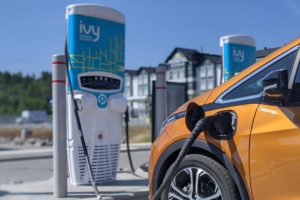


Episode 02
Stephanie Chan and Matt Bubbers: An electrifying conversation on EVs
On episode two of The Climate Challengers, host Andrea Bain is joined by Globe Drive’s Stephanie Chan and Matt Bubbers for an electrifying conversation on electric vehicles (EVs). Andrea, Stephanie and Matt will talk about Ontario’s golden electrification opportunity, the state of play in the evolving EV market and the way that EVs can power Ontario ahead on the road to net-zero.
The future is electric
Electrification is the next big thing in the fight against climate change; a huge sea change in the way we power our lives that will require everyone to get onboard. But electrification is really nothing new. In many ways, it is a journey we have been on for generations.
In Ontario, we’ve been gradually electrifying since just after the days of Confederation. In 1881, a steam generator was used to light a skating rink in Toronto, the first documented occasion of electricity replacing gas lighting in the province. A few years later, Ottawa became the first city in Canada to fully electrify all its streetlights. By World War One, 59,000 customers were connected to the electricity grid in Ontario. Little by little, things that used to rely on wood or coal or oil were able to be electrified thanks to Ontario’s growing electricity sector.
Read more...
The 21st century push to electrification follows a similar trajectory, but one made all the more urgent because of the threats posed by a rapidly changing climate. In the 2020s, electrification still means switching over to powering things with electricity instead of gas or oil. But now that Ontario has achieved one of the cleanest, lowest emission electricity grids in the world, every step we take towards electrification is set to return significant climate fighting benefits—because the electricity we are switching to is largely generated from carbon-free sources like nuclear or hydro.
“Electrification is possibility—it is exciting! This is a once in a century shift,” Matt Bubbers told The Climate Challengers podcast host Andrea Bain. “Generally, electrification is the shift from internal combustion engines powered by, basically, dinosaur bones to cars powered by electric batteries and electric motors,” said Bubbers, an automotive columnist with the Globe and Mail. Bubbers is a car guy—he loves his wheels. But now that he’s driven an all-electric Porsche, Bubbers is all in as a climate challenger, because he is excited about the possibilities unleashed by an electrified future. “I like the feeling of driving a fast car. The first time you drive an electric car it is crazy, they are just so fast. The power, the acceleration is physically shocking,” added an enthused Bubbers.
Host Andrea Bain was also joined on Episode Two of The Climate Challengers by the editor of the Globe and Mail’s Drive section, Stephanie Chan. In contrast to Bubbers, Chan didn’t grow up as someone passionate about cars, but all that has changed. The more she covered the automotive sector and learned about the accelerating opportunities to electrify transportation—and what that could do for the planet—the more excited she became about the future of vehicles and the role she could play as a climate challenger. “It is an interesting time. So much of our technology – not just vehicles – have been powered by fossil fuels for so long and now we’re seeing more and more alternative technologies,” Chan added.
As Ontario looks to accelerate the electrification of the economy and move towards net-zero, Ontario Power Generation (OPG) is zeroing in on the transportation sector, and the role the company can play in supporting a transition to electrified transportation. In Ontario, transportation contributes about one third of the province’s total greenhouse gas (GHG) emissions, which is roughly equivalent to the Canada-wide figure. But across Canada last year, there were only 39,000 pure battery electric vehicles (EVs) sold, compared to 1.4 million internal combustion engine (ICE) vehicles. Electrification has a long way to go, and OPG can help.
In partnership with Hydro One, OPG is building the Ivy Charging Network. Once complete, it will be one of Ontario’s largest, most connected EV charging networks allowing you to travel confidently across the entire province, including the north, in a battery powered EV. And through OPG subsidiary, PowerON Energy Solutions, the company is also playing a lead role in complex electrification projects, such as providing the infrastructure to electrify the TTC’s entire fleet of 2,400 buses by 2035. This is North America’s largest transit electrification project and only the beginning of the huge energy transition now underway.
“In Ontario, and Canada as a whole, we are so well positioned to make the transition to EVs because our electricity grid is so clean,” Bubbers told Bain. That is thanks to the work OPG has done to close every coal-fired power plant in the province. When you power an electric vehicle with electricity generated from coal, you are just substituting one polluting fuel (gas) for another (coal), so the climate fighting benefits are small. But when you power an electric vehicle with electricity that comes from nuclear, hydro, wind and solar sources, you “are poised to get the maximum benefit from electric vehicles that will ultimately help achieve the goal of reducing GHGs and saving the climate,” said Bubbers. Chan sums up Ontario’s electrification opportunity as having “a double-pronged effect on climate change,” because our electricity is so clean.
Electrification also carries additional benefits of distributing demand for energy throughout a 24-hour period, helping to smooth out the peaks and valleys of daily electricity use in Ontario. By charging at night, for example, EVs are a great way to use up the surplus baseload power that is generated overnight when demand is low. In an electrified future, our cars (and even our homes) can charge overnight, and during the day when demand for power is high, the electricity stored in your car can even be sold back to the grid. This means that the more we electrify our lives, the more potential we create to lower the cost of electricity overall.
Still, there are significant obstacles. As Chan points out, EVs can be charged one of two ways: slowly, with what is called a “trickle charge,” or quickly, at the type of fast-charging stations you will find along highways. The trickle charge is best for everyday use, as it extends battery life and vehicle performance, while access to fast charging stations is necessary to make longer trips. The biggest challenge to EV uptake right now is that this charging infrastructure is not always in place. For drivers who park on the street, for example, or in an underground garage, there may not be the infrastructure to plug in their EV for an overnight trickle charge. “It’s not like there are outlets on lampposts for you to plug into,” Chan noted.
Electrification is not just limited to transportation. Going forward, we will need to electrify other sectors that rely on fossil fuels, including home heating and industrial processes. Just as we saw 140 years ago, when electric light bulbs took over from lamp oil, or internal combustion engines replaced the horse and buggy, the next 30 years will see an accelerating shift away from fossil fuels and towards electric power generated from clean sources. With climate challengers like Stephanie Chan and Matt Bubbers at the wheel, steering Canada’s automotive sector towards EVs, Canada is off to a good start. OPG, for its part, is more than ready to help complete this transition to an electrified, net-zero Ontario. In fact, OPG has already begun.
Facts about electrification
3.5 tonnes
of CO2 per year removed from the atmosphere by replacing a gas-powered car with an EV
30% or more
of Ontario’s greenhouse gas emissions come transportation, mostly from cars & trucks
2014 is the year
when OPG last burned coal; a milestone in Ontario’s move to a clean, electrified future
$1,900 in fuel savings
annually by switching to an EV, plus $100s more in annual maintenance savings
Clean energy topics
Other episodes
The information, statements, comments, views and opinions expressed during this podcast are solely those of the program participants and do not necessarily represent those of Ontario Power Generation Inc. or its affiliates.











